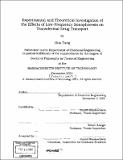Experimental and theoretical investigation of the effects of low-frequency sonophoresis on transdermal drug transport
Author(s)
Tang, Hua, 1972-
DownloadFull printable version (18.58Mb)
Alternative title
Low-frequency sonophoresis on transdermal drug transport
Other Contributors
Massachusetts Institute of Technology. Dept. of Chemical Engineering.
Advisor
Daniel Blankschtein.
Terms of use
Metadata
Show full item recordAbstract
Transdermal drug delivery offers many advantages over traditional drug administration methods such as injections and oral delivery, including increased patient compliance, and avoiding first-pass effects. However, due to the low skin permeability, transdermal drug delivery is currently limited to only a handful of drugs that are hydrophobic and of low molecular weight. The pharmaceutical relevance of many molecules that are excluded from this category, such as proteins, peptides, and DNA, has stimulated the investigation of various skin permeation enhancement methods, among which ultrasound represents a promising skin permeation enhancer. Previous work by our group has shown that ultrasound at a frequency of 20 kHz significantly enhances transdermal transport of drugs, a phenomenon referred to as Low-Frequency Sonophoresis (LFS). The objective of this thesis was to develop a fundamental understanding of the mechanisms of low-frequency sonophoresis (LFS) with an emphasis on the transdermal transport of hydrophilic permeants. An important goal was to utilize this mechanistic understanding to develop guidelines for the rational design of clinical LFS systems. With this in mind, a transport theory was developed to characterize the skin porous pathway of hydrophilic permeants, and to account for the effects of convection during LFS. Through a combined theoretical and experimental investigation of transdermal transport of hydrophilic permeants in both the presence and in the absence of ultrasound, I demonstrated that skin transport of hydrophilic permeants can be described adequately with a skin porous-pathway model. (cont.) The theory developed can be used not only to predict the rate of drug penetration across the skin, but also to characterize the effect of various ultrasound conditions on the skin microscopic transport properties (the effective pore radius and the ratio of porosity to tortuosity of the skin porous pathway), thus enabling the optimization of the ultrasound conditions for the rational design of LFS drug delivery systems. In addition, the theory can potentially be utilized to characterize the effects of other skin permeation enhancers, such as chemical enhancers (for example, water) and iontophoresis, on the skin porous pathway. Based on two-photon microscopy imaging of the 3D-distribution of hydrophilic probes in the skin, the relevance of the intercellular and the intracellular domains for the transport of hydrophilic permeants was inferred. Results suggest that LFS causes the formation of localized transport regions on the skin, and that within each localized transport region, the distribution of the skin pathway of hydrophilic permeants is a function of the skin depth. Specifically, in the superficial region of the skin, the pathway is both intercellular and intracellular, while in the deeper regions of the skin, the pathway is primarily intercellular. This inhomogeneous 3D-distribution of the hydrophilic probe in the skin during LFS suggests heterogeneity in the nature of the skin permeabilization mechanisms by LFS, which could possibly be attributed to the cavitation mechanism ...
Description
Thesis (Ph. D.)--Massachusetts Institute of Technology, Dept. of Chemical Engineering, February 2002. Includes bibliographical references (leaves 267-276).
Date issued
2002Department
Massachusetts Institute of Technology. Department of Chemical EngineeringPublisher
Massachusetts Institute of Technology
Keywords
Chemical Engineering.